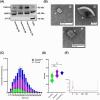Mapping the follicle-specific regulation of extracellular vesicle-mediated microRNA transport in the southern white rhinoceros (Ceratotherium simum simum)†
- PMID: 38775197
- PMCID: PMC11327318
- DOI: 10.1093/biolre/ioae081
Mapping the follicle-specific regulation of extracellular vesicle-mediated microRNA transport in the southern white rhinoceros (Ceratotherium simum simum)†
Abstract
Efforts to implement effective assisted reproductive technologies (ARTs) for the conservation of the northern white rhinoceros (NWR; Ceratotherium simum cottoni) to prevent its forthcoming extinction, could be supported by research conducted on the closely related southern white rhinoceros (SWR; Ceratotherium simum simum). Within the follicle, extracellular vesicles (EVs) play a fundamental role in the bidirectional communication facilitating the crucial transport of regulatory molecules such as microRNAs (miRNAs) that control follicular growth and oocyte development. This study aimed to elucidate the dynamics of EV-miRNAs in stage-dependent follicular fluid (FF) during SWR ovarian antral follicle development. Three distinct follicular stages were identified based on diameter: Growing (G; 11-17 mm), Dominant (D; 18-29 mm), and Pre-ovulatory (P; 30-34 mm). Isolated EVs from the aspirated FF of segmented follicle stages were used to identify EV-miRNAs previously known via subsequent annotation to all equine (Equus caballus; eca), bovine (Bos taurus; bta), and human (Homo sapiens; hsa) miRNAs. A total of 417 miRNAs were detected, with 231 being mutually expressed across all three stages, including eca-miR-148a and bta-miR-451 as the top highly expressed miRNAs. Distinct expression dynamics in miRNA abundance were observed across the three follicular stages, including 31 differentially expressed miRNAs that target various pathways related to follicular growth and development, with 13 miRNAs commonly appearing amidst two different comparisons. In conclusion, this pioneering study provides a comprehensive understanding of the stage-specific expression dynamics of FF EV-miRNAs in the SWR. These findings provide insights that may lead to novel approaches in enhancing ARTs to catalyze rhinoceros conservation efforts.
Keywords: extracellular vesicles; follicular fluid; miRNA; ovarian follicle; rhinoceros.
© The Author(s) 2024. Published by Oxford University Press behalf of Society for the Study of Reproduction.
Figures









References
-
- Hildebrandt TB, Hermes R, Goeritz F, Appeltant R, Colleoni S, de Mori B, Diecke S, Drukker M, Galli C, Hayashi K, Lazzari G, Loi P, et al. The ART of bringing extinction to a freeze - history and future of species conservation, exemplified by rhinos. Theriogenology 2021; 169:76–88. - PubMed
-
- Radcliffe RW, Czekala NM, Osofsky SA. Combined serial ultrasonography and fecal progestin analysis for reproductive evaluation of the female white rhinoceros (Ceratotherium simum simum): Preliminary results. Zoo Biol 1997; 16:445–456.
-
- Pryor P, Tibary A. Management of estrus in the performance mare. Clin Tech Equine Pract 2005; 4:197–209.
MeSH terms
Substances
Grants and funding
LinkOut - more resources
Full Text Sources
Molecular Biology Databases

